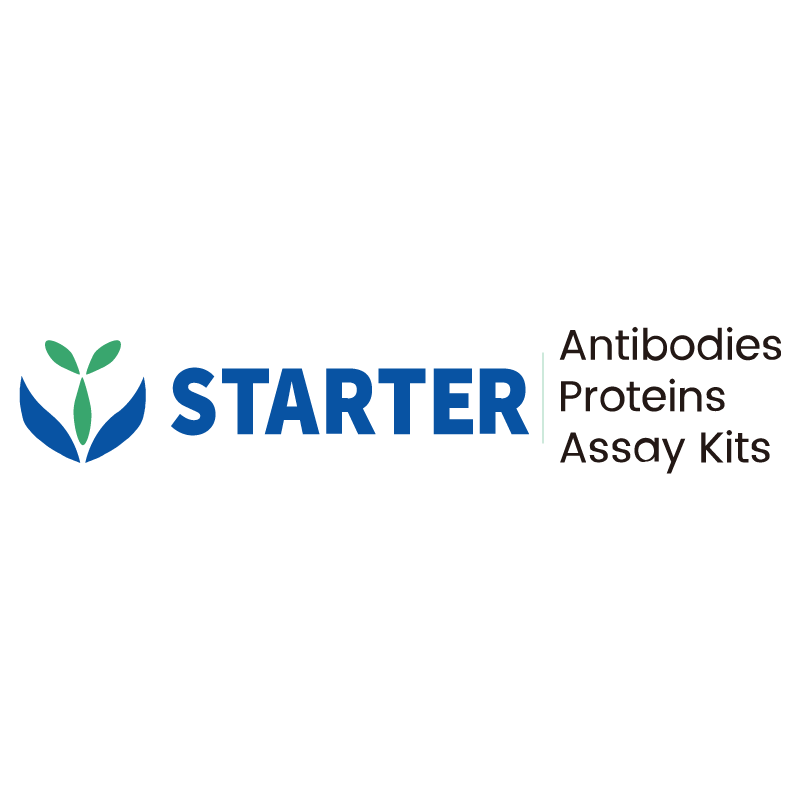WB result of ART1 Recombinant Rabbit mAb
Primary antibody: FOXP2 Recombinant Rabbit mAb at 1/1000 dilution
Lane 1: HeLa whole cell lysate 20 µg
Lane 2: HEK-293 whole cell lysate 20 µg
Lane 3: HepG2 whole cell lysate 20 µg
Lane 4: MCF7 whole cell lysate 20 µg
Secondary antibody: Goat Anti-rabbit IgG, (H+L), HRP conjugated at 1/10000 dilution
Predicted MW: 36 kDa
Observed MW: 33 kDa
Product Details
Product Details
Product Specification
| Host | Rabbit |
| Antigen | ART1 |
| Synonyms | GPI-linked NAD(P)(+)--arginine ADP-ribosyltransferase 1; ADP-ribosyltransferase C2 and C3 toxin-like 1 (ARTC1); Mono(ADP-ribosyl)transferase 1; CD296 |
| Immunogen | Recombinant Protein |
| Accession | P52961 |
| Clone Number | S-2396-1 |
| Antibody Type | Recombinant mAb |
| Isotype | IgG |
| Application | WB, IHC-P |
| Reactivity | Hu, Ms, Rt |
| Positive Sample | HeLa, HEK-293, HepG2, MCF7, mouse skeletal muscle, mouse heart |
| Purification | Protein A |
| Concentration | 0.5 mg/ml |
| Conjugation | Unconjugated |
| Physical Appearance | Liquid |
| Storage Buffer | PBS, 40% Glycerol, 0.05% BSA, 0.03% Proclin 300 |
| Stability & Storage | 12 months from date of receipt / reconstitution, -20 °C as supplied |
Dilution
| application | dilution | species |
| WB | 1:1000 | Hu, Ms |
| IHC-P | 1:1000 | Hu, Ms, Rt |
Background
ART1 (ADP-ribosyltransferase 1) is a glycosylphosphatidylinositol (GPI)-anchored mono-ADP-ribosyltransferase containing an extracellular catalytic domain that modifies target proteins through ADP-ribosylation, thereby regulating diverse cellular functions. Research has demonstrated that ART1 is highly expressed in various cancers (e.g., colorectal cancer, non-small cell lung cancer, and glioblastoma) and associated with poor prognosis. In the tumor microenvironment, ART1 binds to the P2X7 receptor (P2X7R) on CD8⁺ T cells, inducing T cell death and promoting immune evasion and resistance to immune checkpoint inhibitors (ICIs). Additionally, in colorectal cancer, ART1 activates the AKT/mTOR/STAT3 signaling pathway to drive tumor proliferation and enhances tumor growth under high norepinephrine conditions, which is linked to diabetes-associated colorectal cancer progression. Recent studies have identified that ART1-specific antibodies can reverse its immunosuppressive effects and boost anti-tumor immune responses, positioning ART1 as a promising novel target for cancer immunotherapy.
Picture
Picture
Western Blot
WB result of ART1 Recombinant Rabbit mAb
Primary antibody: FOXP2 Recombinant Rabbit mAb at 1/1000 dilution
Lane 1: mouse skeletal muscle lysate 20 µg
Lane 2: mouse heart lysate 20 µg
Secondary antibody: Goat Anti-rabbit IgG, (H+L), HRP conjugated at 1/10000 dilution
Predicted MW: 36 kDa
Observed MW: 39 kDa
Immunohistochemistry
IHC shows positive staining in paraffin-embedded human kidney. Anti-ART1 antibody was used at 1/1000 dilution, followed by a HRP Polymer for Mouse & Rabbit IgG (ready to use). Counterstained with hematoxylin. Heat mediated antigen retrieval with Tris/EDTA buffer pH9.0 was performed before commencing with IHC staining protocol.
IHC shows positive staining in paraffin-embedded human cerebral cortex. Anti-ART1 antibody was used at 1/1000 dilution, followed by a HRP Polymer for Mouse & Rabbit IgG (ready to use). Counterstained with hematoxylin. Heat mediated antigen retrieval with Tris/EDTA buffer pH9.0 was performed before commencing with IHC staining protocol.
IHC shows positive staining in paraffin-embedded human hepatocellular carcinoma. Anti-ART1 antibody was used at 1/1000 dilution, followed by a HRP Polymer for Mouse & Rabbit IgG (ready to use). Counterstained with hematoxylin. Heat mediated antigen retrieval with Tris/EDTA buffer pH9.0 was performed before commencing with IHC staining protocol.
IHC shows positive staining in paraffin-embedded mouse cerebral cortex. Anti-ART1 antibody was used at 1/1000 dilution, followed by a HRP Polymer for Mouse & Rabbit IgG (ready to use). Counterstained with hematoxylin. Heat mediated antigen retrieval with Tris/EDTA buffer pH9.0 was performed before commencing with IHC staining protocol.
IHC shows positive staining in paraffin-embedded rat skeletal muscle. Anti-ART1 antibody was used at 1/1000 dilution, followed by a HRP Polymer for Mouse & Rabbit IgG (ready to use). Counterstained with hematoxylin. Heat mediated antigen retrieval with Tris/EDTA buffer pH9.0 was performed before commencing with IHC staining protocol.


